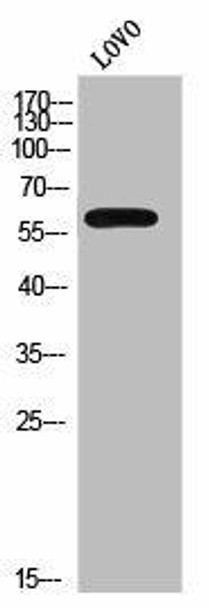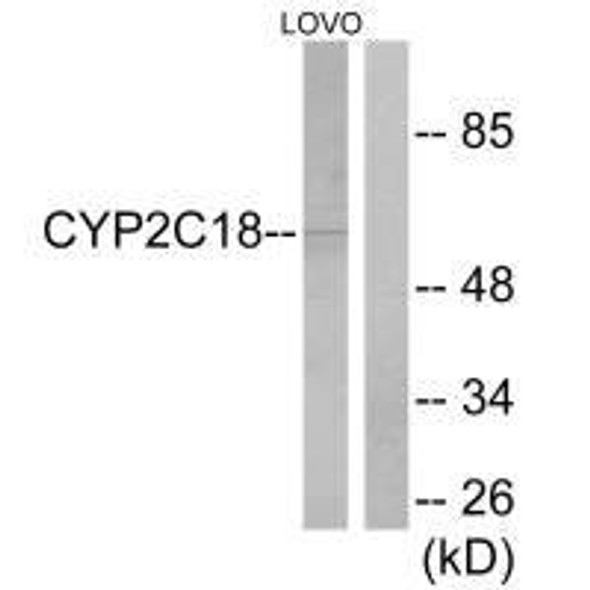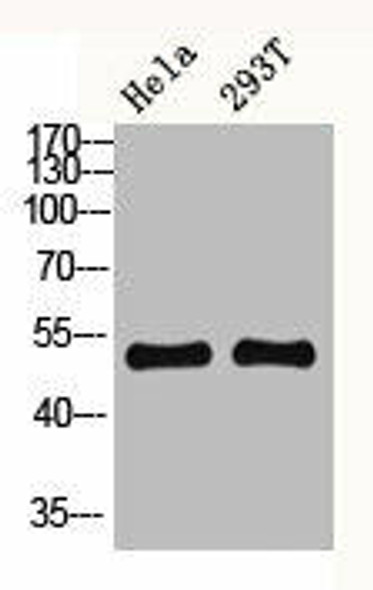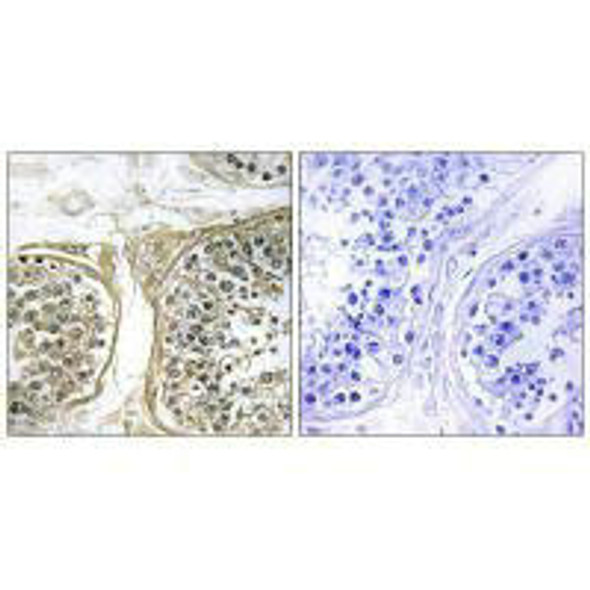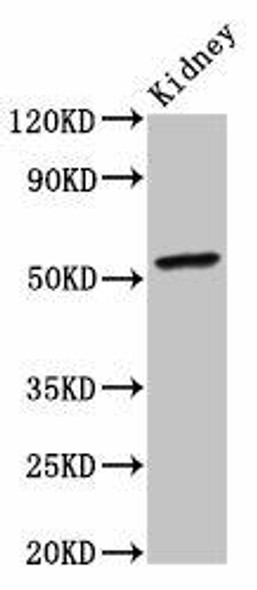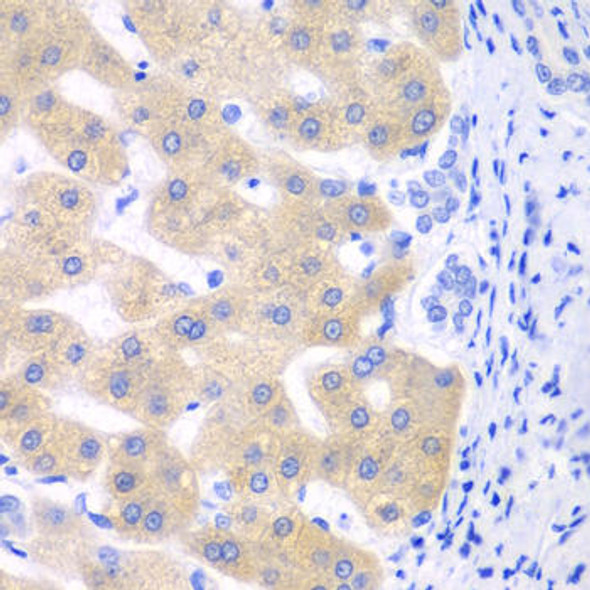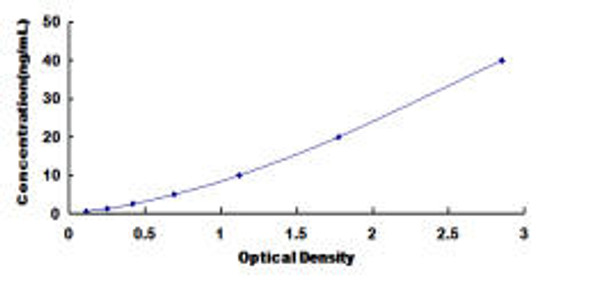Description
CYP2C8/CYP2C9/CYP2C18/CYP2C19 Antibody (PACO02540)
The CYP2C8/CYP2C9/CYP2C18/CYP2C19 Antibody (PACO02540) is a highly specific polyclonal antibody that targets the Cytochrome P450 (CYP) enzymes CYP2C8, CYP2C9, CYP2C18, and CYP2C19. These enzymes play a crucial role in drug metabolism, specifically in the oxidation of drugs and xenobiotics in the liver.This antibody, produced in rabbits, is validated for use in applications such as Western blotting and immunohistochemistry with human samples. It binds specifically to the target enzymes, allowing for their detection and analysis in various cell types and tissues. This makes it an essential tool for research in pharmacology, toxicology, and drug development.
The CYP2C family of enzymes is known to metabolize a wide range of clinically important drugs, including anticoagulants, anticonvulsants, and nonsteroidal anti-inflammatory drugs. Understanding the activity and expression of these enzymes is crucial for predicting drug interactions, individualizing drug therapy, and minimizing adverse drug reactions.Overall, the CYP2C8/CYP2C9/CYP2C18/CYP2C19 Antibody (PACO02540) is a valuable tool for researchers studying drug metabolism, personalized medicine, and drug-drug interactions. Its high specificity and reactivity make it an excellent choice for studies aiming
| Antibody Name: | CYP2C8/CYP2C9/CYP2C18/CYP2C19 Antibody |
| Antibody SKU: | PACO02540 |
| Size: | 50ug |
| Host Species: | Rabbit |
| Tested Applications: | ELISA, WB, IHC, IF |
| Recommended Dilutions: | WB:1:500-1:2000, IHC:1:100-1:300, IF:1:200-1:1000 |
| Species Reactivity: | Human |
| Immunogen: | synthesized peptide derived from the Internal region of human CYP2C8/9/18/19. |
| Form: | Liquid |
| Storage Buffer: | Liquid in PBS containing 50% glycerol, 0.5% BSA and 0.02% sodium azide. |
| Purification Method: | The antibody was affinity-purified from rabbit antiserum by affinity-chromatography using epitope-specific immunogen. |
| Clonality: | Polyclonal |
| Isotype: | IgG |
| Conjugate: | Non-conjugated |
| Synonyms: | CYP2C8; Cytochrome P450 2C8; CYPIIC8; Cytochrome P450 IIC2; Cytochrome P450 MP-12; Cytochrome P450 MP-20; Cytochrome P450 form 1; S-mephenytoin 4-hydroxylase; CYP2C9; CYP2C10; Cytochrome P450 2C9; (R)-limonene 6-monooxygenase; (S)-limonene |
| UniProt Protein Function: | CYP2C8: Cytochromes P450 are a group of heme-thiolate monooxygenases. In liver microsomes, this enzyme is involved in an NADPH-dependent electron transport pathway. It oxidizes a variety of structurally unrelated compounds, including steroids, fatty acids, and xenobiotics. In the epoxidation of arachidonic acid it generates only 14,15- and 11,12-cis-epoxyeicosatrienoic acids. It is the principal enzyme responsible for the metabolism the anti- cancer drug paclitaxel (taxol). Belongs to the cytochrome P450 family. 2 isoforms of the human protein are produced by alternative splicing. |
| UniProt Protein Details: | Protein type:Lipid Metabolism - arachidonic acid; EC 1.14.14.1; Oxidoreductase; Xenobiotic Metabolism - drug metabolism - cytochrome P450; Lipid Metabolism - linoleic acid; Xenobiotic Metabolism - metabolism by cytochrome P450; Cofactor and Vitamin Metabolism - retinol Chromosomal Location of Human Ortholog: 10q23.33 Cellular Component: endoplasmic reticulum membrane Molecular Function:arachidonic acid epoxygenase activity; monooxygenase activity; oxygen binding; steroid hydroxylase activity Biological Process: drug metabolic process; epoxygenase P450 pathway; exogenous drug catabolic process; organic acid metabolic process; xenobiotic metabolic process |
| NCBI Summary: | This gene encodes a member of the cytochrome P450 superfamily of enzymes. The cytochrome P450 proteins are monooxygenases which catalyze many reactions involved in drug metabolism and synthesis of cholesterol, steroids and other lipids. This protein localizes to the endoplasmic reticulum and its expression is induced by phenobarbital. The enzyme is known to metabolize many xenobiotics, including the anticonvulsive drug mephenytoin, benzo(a)pyrene, 7-ethyoxycoumarin, and the anti-cancer drug taxol. This gene is located within a cluster of cytochrome P450 genes on chromosome 10q24. Several transcript variants encoding a few different isoforms have been found for this gene. [provided by RefSeq, Nov 2010] |
| UniProt Code: | P10632 |
| NCBI GenInfo Identifier: | 117225 |
| NCBI Gene ID: | 1558 |
| NCBI Accession: | P10632.2 |
| UniProt Secondary Accession: | P10632,Q5VX93, Q8WWB1, Q9UCZ9, A8K9N8, B0AZN2, B7Z1F6 |
| UniProt Related Accession: | P10632 |
| Molecular Weight: | 44,358 Da |
| NCBI Full Name: | Cytochrome P450 2C8 |
| NCBI Synonym Full Names: | cytochrome P450 family 2 subfamily C member 8 |
| NCBI Official Symbol: | CYP2C8 |
| NCBI Official Synonym Symbols: | CPC8; CYPIIC8; MP-12/MP-20 |
| NCBI Protein Information: | cytochrome P450 2C8 |
| UniProt Protein Name: | Cytochrome P450 2C8 |
| UniProt Synonym Protein Names: | CYPIIC8; Cytochrome P450 IIC2; Cytochrome P450 MP-12; Cytochrome P450 MP-20; Cytochrome P450 form 1; S-mephenytoin 4-hydroxylase |
| Protein Family: | Cytochrome |
| UniProt Gene Name: | CYP2C8 |
| UniProt Entry Name: | CP2C8_HUMAN |

